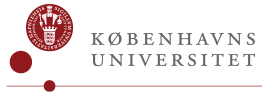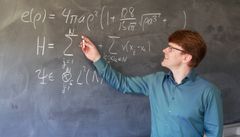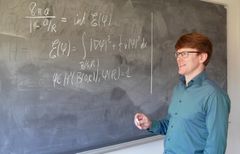Leading mathematician wants to solve the riddle of a million quantum particles: "It can only be done with a blackboard, chalk and plenty of coffee"
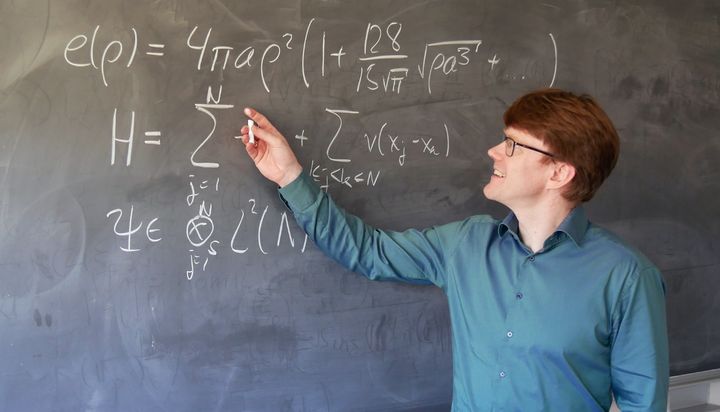
"Imagine one of those spectacular opening ceremonies at the Olympics, where a huge crowd suddenly gathers as a unit and synchronizes its movements like a flock of starlings. In a few very special and strange cases, the same occurs in the world of atoms. In them, a million atoms that have all entered the same quantum state behave completely synchronously," explains University of Copenhagen math professor Søren Fournais.
Fournais is referring to the mysterious quantum phenomenon known as Bose-Einstein condensates. These can occur if certain kinds of atoms are successfully cooled to temperatures near absolute zero. Here, anywhere from 100,000 to several million atoms entangle, with all of them transitioning into the same quantum state at the same moment – a point at which the substance is neither solid, liquid, gas nor plasma. It is often described as being in its own fifth state.
While Bose and Einstein predicted the existence of such a phenomenon in the 1920’s, it wasn’t until 1995 that a Bose-Einstein condensate was produced in the lab – a Nobel Prize winning achievement. And even though researchers worldwide are busy exploring the new quantum state, much remains a mystery.
"Our general understanding of these extreme physical systems is incomplete. We lack the mathematical tools to analyse and understand condensates and thereby the ability to possibly put them to good use. The mathematical challenge is that you have a tremendous number of particles interacting with each other, and that the correlations between these particles are crucial for their behavior. The equations were written down a long time ago, but one cannot just solve them. In the years ahead, we’ll focus on understanding these solutions," says University of Copenhagen mathematics professor Søren Fournais.
Fournais is one of the world's leading researchers in quantum mechanical equations and has already spent ten years of his career wrestling with the wondrous nature of Bose-Einstein condensates. He is now dedicating the next five years to getting closer to the phenomenon’s complex mathematical solutions. To do so, the European Research Council has awarded him DKK 15 million through one of its highly prestigious ERC Advanced Grants.
An atom visible to the naked eye
Quantum mechanics takes place in the micro-world of atoms, within which the quantum effects are so minuscule that we do not experience them in our daily lives. The truly fascinating aspect of a Bose-Einstein condensate is that because it is made up of huge masses of atoms, it is nearly large enough to be observed with the naked eye. This makes it ideal for teaching us about quantum mechanics and for conducting experiments on a scale large enough to actually see them.
Researchers around the world are working to exploit the quantum properties of Bose-Einstein condensates in various ways. In 2022, Dutch scientists built an atomic laser based on a Bose-Einstein condensate. Danish professor Lene Hau of Harvard University has demonstrated that she can stop the light using a Bose-Einstein condensate. Work is also underway around the world to base a quantum computer on these icy atoms. However, there are still plenty of bumps in the road and the condensates are still only used at the basic research level.
According to Søren Fournais, the missing answers are found in the equations – or at least the theoretical answers:
"The beautiful and fascinating thing about mathematical physics is that we can write down the laws of nature in relatively simple equations on a piece of paper. Those equations contain an incredible amount of information – in fact, all the answers. But how can we extract the information that tells us what we want to know about these wild physical systems? It's a huge challenge, but it's possible," says Fournais.
The big dream
As with the phase transition that occurs when water freezes into ice, Bose-Einstein condensation, in which atoms transition to a quantum state, is a phase transition. It is this physical transformation that Søren Fournais dreams of finding the mathematical solution to.
"My big dream is to mathematically prove the phase transition that the Bose-Einstein condensation is.But demonstrating phase transition is notorious for being extremely difficult, because you go from particles moving randomly about to them sticking. A symmetry is broken. It is very difficult to see why the particles do so and exactly when it will happen. Consequently, up until now, there is only one physical system where we have succeeded in saying something mathematical about this phase transition," says Fournais, who adds:
"I think that it’s unrealistic to solve this task in five years but hope that the project will get us closer than we are today. And then we have many intermediate objectives that we hope to achieve along the way."
Over the past 5-10 years, Professor Fournais has been behind some of the most significant global breakthroughs having to do with the mathematical understanding of Bose-Einstein condensates. Among other things, he proved the formula for the ground-state energy of a Bose-Einstein condensate – a question that had remained unanswered since about 1960.
Blackboard, chalk and lots of coffee
So, how does one of Europe's leading mathematicians approach such a task? According to Søren Fournais, it doesn’t happen in front of a computer:
"A computer can make a numerical calculation for 10 or 20 particles, but not a million. So, the computer is not a useful tool for us. Instead, it's a matter of a lot of coffee, good ideas and hard work at the blackboard with chalk," says the researcher, who concludes:
"A typical week begins with a few good new ideas from the previous weekend that you are eager to pursue. And then you work – Monday, Tuesday and Wednesday – until it seems to be progressing. Except that on Thursday, you realize that it isn’t. But you get wiser. And then, the next round of ideas for the following week is perhaps a bit more tested. And then at some point, everything falls into place."
FACT BOX: SØREN FOURNAIS
- Søren Fournais was born in 1973 and is a professor at the University of Copenhagen’s Department of Mathematical Sciences and QMATH research centre. He has previously received an ERC Starting Grant (2008) and the prestigious EliteForsk Prize (Elite Research Prize) in 2018.
- Professor Fournais' new research project will take place at QMATH (Centre for the Mathematics of Quantum Theory). The centre is a world leader in the mathematical understanding of quantum physics.
- The ERC Advanced grant is awarded by the European Research Council for world-class research. Grants are awarded to excellent researchers at the highest level and are to be used to build a team around an original and groundbreaking research idea.
FACT BOX: WITH A LITTLE HELP FROM EINSTEIN
- In the 1924, Indian physicist Satyendra Nath Bose predicted that, at temperatures around absolute zero, the elementary particle photons can be in a special state where they are unable to be separated and all behave quantum mechanically. Since no one wanted to print Bose's theory, he enlisted the help of the more renowned Einstein to have it published in a journal. Einstein later developed the theory himself to include massive particles. The phenomenon was named Bose-Einstein condensates.
- In 1995, the physicists Wolfgang Ketterle, Eric A. Cornell and Carl E. Wieman were the first to produce a Bose-Einstein condensate in a laboratory. For this, they were awarded the 2001 Nobel Prize in Physics.
Keywords
Contacts
Søren Fournais
Professor
Department of Mathematical Sciences
University of Copenhagen
sofo@math.ku.dk
+45 35 32 95 79
Maria Hornbek
Journalist
Faculty of Science
University of Copenhagen
maho@science.ku.dk
+45 22 95 42 83
Images
Links
About Københavns Universitet - Det Natur- og Biovidenskabelige Fakultet
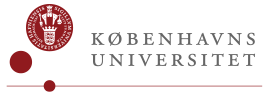 Københavns Universitet - Det Natur- og Biovidenskabelige Fakultet
Københavns Universitet - Det Natur- og Biovidenskabelige FakultetBülowsvej 17
1870 Frederiksberg C
35 33 28 28https://science.ku.dk/
Det Natur- og Biovidenskabelige Fakultet på Københavns Universitet – SCIENCE – er landets største naturvidenskabelige forsknings- og uddannelsesinstitution.
Fakultetets væsentligste opgave er at bidrage til løsning af de store udfordringer, som vi står overfor i en verden under hastig forandring med øget pres på bl.a. naturressourcer og markante klimaforandringer - både nationalt og globalt.
Subscribe to releases from Københavns Universitet - Det Natur- og Biovidenskabelige Fakultet
Subscribe to all the latest releases from Københavns Universitet - Det Natur- og Biovidenskabelige Fakultet by registering your e-mail address below. You can unsubscribe at any time.
Latest releases from Københavns Universitet - Det Natur- og Biovidenskabelige Fakultet
Old aerial photos give scientists a new tool to predict sea level rise3.7.2025 08:00:00 CEST | Press release
Researchers from the University of Copenhagen have gained unique insight into the mechanisms behind the collapse of Antarctic ice shelves, which are crucial for sea level rise in the Northern Hemisphere. The discovery of old aerial photos has provided an unparalleled dataset that can improve predictions of sea level rise and how we should prioritise coastal protection and other forms of climate adaptation.
Gamle luftfotos giver forskere nyt redskab til at forudsige havstigninger3.7.2025 08:00:00 CEST | Pressemeddelelse
Forskere fra Københavns Universitet har fået unik adgang til at forstå mekanismerne bag antarktiske ishylders kollaps, som er afgørende for havstigninger på den nordlige halvkugle. Et fund af gamle luftfotos har skabt et enestående datasæt, som kan forbedre vores forudsigelser af hvor meget havene stiger, og vores prioritering af kystsikring og andre klimatilpasninger.
Ny institutleder på IFRO: ”Faglighed og fællesskab går hånd i hånd”1.7.2025 10:49:17 CEST | Pressemeddelelse
Per Svejstrup er fra 1. august ansat som institutleder på Institut for Fødevare- og Ressourceøkonomi (IFRO). Den kommende leder træder ind i rollen med stor respekt for IFRO's faglige og kollegiale kultur med klare ambitioner for fremtiden.
Dangerous Variant of Salmonella Still Not Eradicated – Researchers Point to the Solutions1.7.2025 09:53:23 CEST | Press release
The infectious and multi-resistant cattle disease Salmonella Dublin can be fatal to both humans and animals and causes significant losses for farmers. Although Denmark has attempted to eradicate the disease since 2008, it has not yet succeeded. A study from the University of Copenhagen points to possible reasons – and the necessary solutions.
Farlig type salmonella er stadig ikke nedkæmpet i Danmark – forskere peger på løsningerne30.6.2025 09:54:03 CEST | Pressemeddelelse
Den smitsomme og multiresistente kvægsygdom Salmonella Dublin kan være dødelig for både mennesker og dyr og medfører desuden betydelige tab for landmændene. Selvom Danmark har forsøgt at udrydde sygdommen siden 2008, er det ikke lykkedes. Et studie fra Københavns Universitet peger på den mulige årsag og de nødvendige løsninger.
In our pressroom you can read all our latest releases, find our press contacts, images, documents and other relevant information about us.
Visit our pressroom